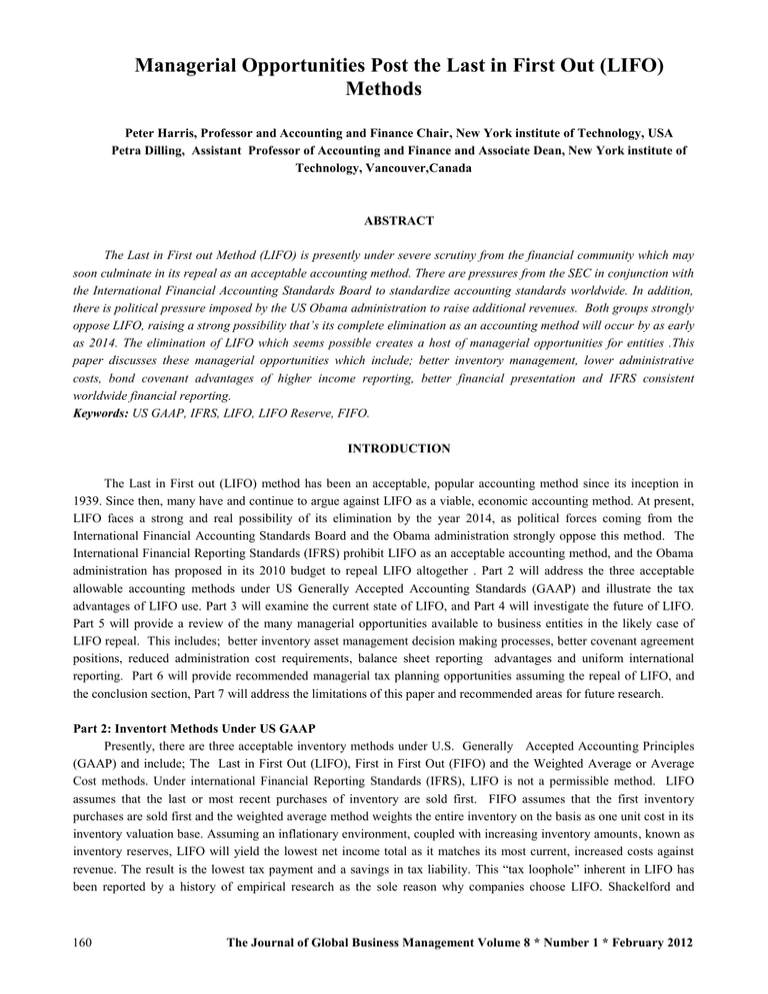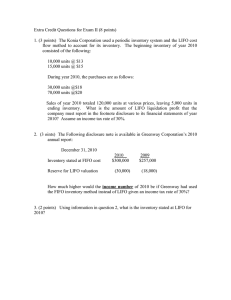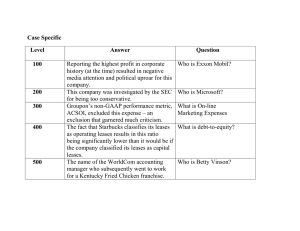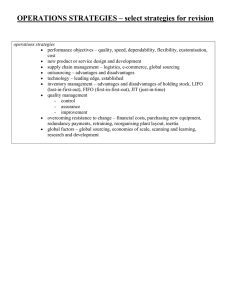
Managerial Opportunities Post the Last in First Out (LIFO)
Methods
Peter Harris, Professor and Accounting and Finance Chair, New York institute of Technology, USA
Petra Dilling, Assistant Professor of Accounting and Finance and Associate Dean, New York institute of
Technology, Vancouver,Canada
ABSTRACT
The Last in First out Method (LIFO) is presently under severe scrutiny from the financial community which may
soon culminate in its repeal as an acceptable accounting method. There are pressures from the SEC in conjunction with
the International Financial Accounting Standards Board to standardize accounting standards worldwide. In addition,
there is political pressure imposed by the US Obama administration to raise additional revenues. Both groups strongly
oppose LIFO, raising a strong possibility that’s its complete elimination as an accounting method will occur by as early
as 2014. The elimination of LIFO which seems possible creates a host of managerial opportunities for entities .This
paper discusses these managerial opportunities which include; better inventory management, lower administrative
costs, bond covenant advantages of higher income reporting, better financial presentation and IFRS consistent
worldwide financial reporting.
Keywords: US GAAP, IFRS, LIFO, LIFO Reserve, FIFO.
INTRODUCTION
The Last in First out (LIFO) method has been an acceptable, popular accounting method since its inception in
1939. Since then, many have and continue to argue against LIFO as a viable, economic accounting method. At present,
LIFO faces a strong and real possibility of its elimination by the year 2014, as political forces coming from the
International Financial Accounting Standards Board and the Obama administration strongly oppose this method. The
International Financial Reporting Standards (IFRS) prohibit LIFO as an acceptable accounting method, and the Obama
administration has proposed in its 2010 budget to repeal LIFO altogether . Part 2 will address the three acceptable
allowable accounting methods under US Generally Accepted Accounting Standards (GAAP) and illustrate the tax
advantages of LIFO use. Part 3 will examine the current state of LIFO, and Part 4 will investigate the future of LIFO.
Part 5 will provide a review of the many managerial opportunities available to business entities in the likely case of
LIFO repeal. This includes; better inventory asset management decision making processes, better covenant agreement
positions, reduced administration cost requirements, balance sheet reporting advantages and uniform international
reporting. Part 6 will provide recommended managerial tax planning opportunities assuming the repeal of LIFO, and
the conclusion section, Part 7 will address the limitations of this paper and recommended areas for future research.
Part 2: Inventort Methods Under US GAAP
Presently, there are three acceptable inventory methods under U.S. Generally Accepted Accounting Principles
(GAAP) and include; The Last in First Out (LIFO), First in First Out (FIFO) and the Weighted Average or Average
Cost methods. Under international Financial Reporting Standards (IFRS), LIFO is not a permissible method. LIFO
assumes that the last or most recent purchases of inventory are sold first. FIFO assumes that the first inventory
purchases are sold first and the weighted average method weights the entire inventory on the basis as one unit cost in its
inventory valuation base. Assuming an inflationary environment, coupled with increasing inventory amounts, known as
inventory reserves, LIFO will yield the lowest net income total as it matches its most current, increased costs against
revenue. The result is the lowest tax payment and a savings in tax liability. This “tax loophole” inherent in LIFO has
been reported by a history of empirical research as the sole reason why companies choose LIFO. Shackelford and
160
The Journal of Global Business Management Volume 8 * Number 1 * February 2012
Sheulin (2001) have documented the tax motivated effect of LIFO. Dopuch and Pincur (1988) found that the taxation
effect was the primary reason a company chose LIFO.
An example will illustrate this LIFO “tax loophole” scenario.
Suppose Company X in its first year of operation purchases inventory as follows: (Rising prices or inflationary
trend). The cost of Goods Sold is calculated below:
January 15
March 15
June 15
December 15
Total
Units
100 units
100 units
100 units
100 units
400 units
Cost/unit
@$10
@10.20
@10.40
@10.60
Total cost
=
=$1000
=1020
=1040
=1060
$ 4120
At year end, an inventory count reveals 20 units in its ending inventory.
The following costs of goods sold would result under the following three methods of accounting (FIFO, LIFO and
weighted average):
FIFO
Beginning inventory
+ Purchases
Total available for sale
Less Ending Inventory
Cost of Goods Sold
LIFO
0
$4120
4120
1
(212)
$3908
Weighed average
0
$4120
4120
2
(200)
$ 3920
0
$4120
4120
3
(206)
$3914
1. FIFO: The ending inventory is represented by the last purchases made at $10.60 each. (20 x $10.60 = $212)
2. LIFO: The ending inventory is represented by the first purchases made at $10 each. (20 x $10.00 = $200)
3. Weighted average: The ending inventory is represented by the weighted average cost: Total cost/total units = $4120/400 = $10.30 per unit
Results:
LIFO will result in a $12 higher cost then FIFO by virtue of inflation. This will result in a pretax lower income of
$12 and a tax savings of $12 times the tax rate. Assuming a 40% tax bracket, LIFO will result in a lower tax payment
of 40% x 12 or $4.80, and a lower net income of $12-$4.80 or $7.20. FIFO will result in a higher pretax income of $12,
a higher tax payment of $4.80 and a higher net income of $7.20. (The weighted average method results will be between
the LIFO and FIFO method. The result is that LIFO firm will have an additional $4.80 of cash as a result of the “tax
loophole” when compared to FIFO.
LIFO if used for tax purposes needs to be used for financial reporting differences. This requirement is known as
the LIFO conformity rule. This requirement does not have a negative impact on the LIFO firm if one assumes the
empirical aspect of the efficient market hypothesis (Fama). This requirement will not impact stock price, and if one
considers the tax savings by the use of LIFO, LIFO use should increase stock price. Finally, US GAAP requires the
disclosure of the difference between the FIFO and LIFO Inventory Balance Sheet values, known as the LIFO Reserve.
In this example, the LIFO Reserve is $12 calculated as follows; FIFO Inventory value at year end of $212 less LIFO
Inventory value at year-end of $200. It is also important to realize that a company can control its purchasing decisions
and add to the inventory reserve amount simply by purchasing additional inventory by year end.
Part 3: Current State of Lifo
LIFO is facing pressures from both: the International Reporting Standards Board in cooperation with the SEC and
the U.S. Congress for its possible complete elimination by the year 2014.On November 15, 2007, the Securities and
Exchange Commission (SEC) exempted foreign firms from including reconciliation from International Financial
Reporting Standards (IFRS) to U.S Generally Accepted Accounting Principles, (U.S. GAAP) when filing on U.S. Stock
The Journal of Global Business Management Volume 8 * Number 1 * February 2012
161
exchanges. Foreign public firms are now permitted to file using the International Financial Reporting Standards (IFRS)
without reconciliation to U.S. GAAP as previously required. This move has created a mandate to converge IFRS and
U.S. GAAP and financial statement requirements (SEC, 2007)On June, 18, 2008 the SEC issued a press release stating
that the world’s securities regulators are uniting to increase their oversight of international accounting standards. There
are plans set forth by the SEC and the IFRS to standardize accounting standards, on a worldwide basis with a target date
set for periods ending after December 31, 2014. Under IFRS rules, LIFO is not a permitted acceptable accounting
method. IFRS is balance sheet oriented and on this basis, disallows LIFO as an inventory method. The use of LIFO
disrupts the theoretical foundation of the IFRS and if plans proceed as expected, complete phase out of LIFO will occur
in the near future. More importantly is the current tax position on LIFO. The Obama Administration has proposed in its
2010 budget to repeal LIFO altogether in an attempt to generate greater tax revenues. Given the ongoing and increasing
international opposition to LIFO, coupled with the current spiraling US federal deficit, its support base is very unstable.
Senator Rangle, the biggest opponent o LIFO has estimated a loss of $100 billion of US tax revenue by the use of
LIFO. This figure is exaggerated when figures from Compustat place the LIFO Reserve total at $100 Billion , making
the tax revenues amount closer to $35 Billion (assuming a corporate tax rate of 35 percent).
PART 4: The Future of LIFO
There are four possibilities of LIFO going forward, and illustrated as follows:
Case
Financial Reporting
1
Yes
2
No
3
Yes
4
No
Tax Rules
Yes
Yes
No
No
In case 1, LIFO would continue as present. Given extreme dual resistance from IFRS and Congress, this result
seemed unlikely until recent 2011 developments. Senator Rangel resigned due to ethical violations, the US recession
renewed and there is a US presidential election coming up in 2012, which is far more critical than LIFO repeal. As such,
LIFO is probably going to continue and be reevaluated again after the election year of 2012.Further, if a republican is
elected president, the repeal of LIFO in the near future becomes remote.In case 2, allowing LIFO for tax purposes and
not for financial reporting purposes represents the best of both world, as a company report the highest income for
financial reporting purposes and pay the least amount of tax. The scenario would effectively eliminate the LIFO
conformity requirement. The likelihood of this happening is most unlikely and not feasible.In case 3, represents the
worst of both worlds for a company; that is, the lowest income for financial reporting and the highest tax payment. This
scenario is also not feasible.Case 4 represents the complete elimination of LIFO. If LIFO is eliminated at the tax level
then it will be eliminated for financial reporting purposes as the advantage for business purposes would not exist.
Given the huge U.S. budget deficit, the few select beneficiaries of LIFO use which include some of the most profitable
industries such as the oil produces, and the movement to a uniform worldwide accounting reporting standard whose
passage is dependent on the abolishment of LIFO, LIFO’s repeal seemed probable until 2011(as explained in case 1
above). We believe that LIFO will ultimately be eliminated, but not anytime in the near future. We believe that LIFO
will continue well beyond the IFRS-US GAAP convergence, which is expected to occur by December 31, 2014.
PART 5: Managerial Opportunities Available to Non Lifo Users
1.Better Inventory Management
Increasing physical inventory totals lead to added costs, which results in poor inventory management. Carrying
costs such as storage, insurance, maintenance, interest and obsolescence are associated with high levels of inventory.
LIFO by virtue of its inherent tax advantage encourages buildup in inventory amounts which results in higher cost and
poor asset management decision criteria. Frankel and Trezevant (1994) examined the year-end purchasing decisions of
firms as a function of their tax accounting methods and concluded based on their findings “that additional year-end
LIFO inventory purchases appear to be made for tax reasons suggests that permitting the LIFO methods to be used for
tax purposes leads to inventory management inefficiencies.”
Non LIFO firms can avail themselves to a Just In Time (JIT) inventory method. JIT methods require inventory
purchases only when needed, and as such, is the most efficient and cost effective method of inventory management.
There is significant cost savings in not having inventory build -up which counters the tax benefit aspect of this strategy.
162
The Journal of Global Business Management Volume 8 * Number 1 * February 2012
2-Bond Covenant Advantage
The use of LIFO can disrupt a company’s financial policies as directed by bond covenant agreements. LIFO will
produce more conservative, lower income, asset and shareholders’ equity values than FIFO, resulting in lower liquidity,
leverage and profitability ratios. This may create forced prepayment of bonds due to a failure to must legal financial
requirements. As an example, if a bond covenant requires a company to maintain a minimum current ratio, and a
maximum debt ratio (see appendix 1), then LIFO will result in more compromising ratios when compared to FIFO.
FIFO will produce greater income and asset totals which help maintain covenant requirements to a greater degree.
3- Added Administrative Costs
Most if not all companies employing LIFO will maintain several different inventory methods to report internal
and external accounting requirements. Many companies use LIFO for tax and external reporting purposes but maintain
a FIFO or standard cost systems for internal reporting purposes. There are several reasons to do so: (1) Companies
often base their pricing decisions on a FIFO, or standard cost assumptions, rather than on a LIFO basis. (2) Record
keeping on some other basis is easier because the LIFO assumption usually does not approximate the physical flow of
the product. (3) Profit-sharing and other bonus arrangements are often not based on a LIFO inventory assumption.
Finally, (4) the use of a pure LIFO system is troublesome for interim periods, for which estimates must be made of
year-end quantities and prices. (Kieso, Weygandt, and Warfield, 2005).
Additionally, LIFO reserve presentation and disclosure is necessary, further compounding accounting compliance
requirements, resulting in added recordkeeping costs. The use of LIFO then is costly from both; an asset management
position, an administrative aspect and it also results in a bond covenant compromise position.
4. Balance Sheet Presentation
Since LIFO expenses its most recent inventory acquisitions to cost, the ending inventory balance presentation is
composed of the oldest inventory purchases, making the balance sheet potentially and practically very inaccurate. From
a non- tax aspect, this is the most viable argument against LIFO. An example will illustrate this shortcoming; if Sunoco
purchased 10,000 barrels of oil in 1959 for $15 per barrel, and the 10,000 barrels remained in the accounting records as
ending inventory in 2011, when the cost per barrel is $90, an assumption which is easily satisfied assuming an
increasing inventory trend, then the LIFO balance sheet total for inventory in 2011 is materially misstated. Under LIFO,
ending inventory in 2011 is 10,000 barrels x $15 = $150,000 (1959 prices), whereas the more accurate valuation which
would be reflected under FIFO is 10,000 barrels x $90 = $900,000 (most current prices), resulting in an understatement
of $750,000 or 83 % of asset value. LIFO produces unrealistic Balance Sheet Inventory totals when compared to
economic reality. LIFO is too conservative and yields unrealistic financial totals for inventory, current assets, total
assets, and Shareholders’ Equity. The result is a balance sheet presentation of very limited usefulness to the financial
user. Note also, that this company has gained a tax advantage of $750,000 times the tax rate over the years.
The result is that LIFO has no real application to the balance sheet, and any type of analysis from this is not viable.
FIFO on the other hand is depictive of true inventory values as it expenses the earliest inventory and maintains it’s most
current inventory for balance sheet presentation. In our example, FIFO would reflect an ending inventory of 10,000
barrels X $90 or $900,000, an amount reflective of the true economic picture. FIFO then is balance sheet friendly and
any type of ratio analysis involving Balance Sheet Inventory valuation should use FIFO as its base. As the following
examples illustrate, if we wanted to calculate Return on Assets = Operating Income/Total Assets, the asset base should
include inventory on the FIFO basis. In term of debt ratio = Liabilities/Assets, the asset base again should include
inventory on the FIFO basis (see appendix 1). The use of LIFO in asset, including inventory type ratios is not correct
and the adjustment to FIFO via the LIFO reserve should be made prior to calculating, interpreting and recommending
on balance sheet related ratios.
Romeo (2009) has noted that most oil producers have inventory purchases made before World War II presented
on their Balance Sheet. Additionally, many of these firms also have a material amount of LIFO reserves when
The Journal of Global Business Management Volume 8 * Number 1 * February 2012
163
compared to total assets and stockholders Equity, making LIFO presentation inapplicable. In the case of Sunoco, the
LIFO reserve amount exceeds the Shareholders’ Equity total.
5. International Reporting Standards
As stated earlier, IFRS does not allow LIFO as an accounting method. This creates several problems:
1) The standardization of one single set of accounting standards as proposed by the US Congress may be conditional
upon the elimination of LIFO. LIFO is in effect delaying convergence to IFRS reporting.
2) Cross country comparisons of financial statements will continue to be difficult if LIFO is still maintained. LIFO is a
US phenomenon, and the rest of the world does not use it. Comparing a European firm using FIFO to a US company
using LIFO makes financial analysis and comparability difficult. World standardization of financial reporting will
greatly alleviate the problem of accounting engineering.
Part 6: Tax Planning Opportunities Available for the Current Users of Lifo
In the unlikely event that LIFO is indeed repealed by the Obama administration for the period ending after tax
year 2011, what are some of the tax planning opportunities available to taxpayers?1. Section 481(a) Adjustment
Period:Under current tax rules, if a taxpayer charges its accounting period form LIFO to another acceptable method, and
it results in a higher inventory value, the difference in additional tax is payable over a period of four years. Under the
current Obama Administration’s 2010 Budget Proposal, which would eliminate LIFO, the difference would be spread to
taxable income and payable over eight years. Consequently, the termination of LIFO would be mitigated as the
resulting extra tax would be payable to the tax authorities over an eight year period. 2.Use of FIFO coupled with the
Lower of Cost or Market (LCM) method:If a non LIFO method is used, the tax rules allow the use of the LCM rule to
value inventories. LCM allows inventory to be valued below cost if cost exceeds market value. Market value is
defined as replacement cost and such valuation can be made on an item by item basis. As an example, a company may
use and to take a tax advantage prior to sale by the use of non LIFO LCM method. This however is not a viable option
for LIFO users, as these companies historically experience increasing rather than deflationary inventory costs.3.Net
Operating Loss:Given the current recession, a company may have encountered losses in the last two years. Under
current U.S. tax rules, such losses can be used to offset in part or in full, past profits for the last 2 years and/or future
profit for the next 20 years; known as the 2/20 rule. A change from LIFO to FIFO will result in a higher income amount
in the year of adoption, but this added income may be offset by past net operating losses, minimizing the tax effect of
LIFO repeal.
Part 7: Conclusion
The probability of the elimination of LIFO as an acceptable accounting method is real and possible. This paper
addressed the present and future states of LIFO and presented the many managerial opportunities available to firms that
would be forced to relinquish LIFO as their inventory accounting method. The possible repeal of LIFO should be
viewed as favorable as it will allow companies to adhere to cost effective, efficient inventory management policies,
show improved earnings and Balance Sheet presentation, which will aid in their long term borrowing and bond
covenant needs, while reducing administrative costs of needing to maintain multiple accounting records. Additionally, it
will help society in that there will be consistency in accounting reporting worldwide as LIFO’s repeal will potentially
pave for the convergence of standardizing International Financial Accounting Standards. Finally, it will raise additional
sums of tax revenue for the US government.The limitations of our research are that the repeal of LIFO will not occur
and possibly, the tax saving inherent in LIFO is greater than the managerial benefits of non LIFO use. Further research
should be done in this matter to quantify the tax savings aspect of LIFO when compared to the extra costs of inventory
inefficiency and inventory reserves, added administrative costs and the negative potential impact of early
extinguishment of debt.
164
The Journal of Global Business Management Volume 8 * Number 1 * February 2012
Appendix 1: Selected Financial Ratios
I. Liquidity:
1. Current Ratio:
Current Assets
Current Liabilities
II. Leverage
2. Debt Ratio:
Total Liabilities
Average Total Assets
III. Profitability
3. Gross Profit Ratio:
Sales – Cost of Goods Sold
Sales
Net Income
Sales
Operating Income
Average Total assets
4. Net Income Ratio:
5. Return on Assets Ratio:
IV. Activity
6. Return on Assets:
Earnings Before Internet and Tax/Operating Income
Average Total Assets
7. Return on Stockholders’ Equity
Net Income
Average Stockholders’ Equity
Comments: FIFO will provide better financial ratios for all of the above.
REFERENCES
Dopush, N, and Pincus, M ., (spring, 1988), Evidence of the Choice of Inventory Accounting methods: LIFO versus FIFO, Journal of Accounting
Review.
Fama, E., (May.1970), Efficient Capital Markets: A Review of theory and Empirical Work, Journal of Finance.
Frankel, M., Trezevan, R., (April, 1994). The Year End LIFO Inventory Purchasing Decision: An Empirical Test, The Accounting Review.
P. Harris, (June 15-17, 2012),The Positive Outlook of the Last In First Out Inventory Method,2012 Global Business & International Management
Conference, Orlando, Florida, USA.
Hunt, H., (autumn, 1985), Potential Determinants of Corporate inventory Accounting Decisions, Journal of Accounting Research.
.International Financial Accounting Standards (IFRS).
Internal Revenue Code (I.R.C.) 471 and Treasury Regulations 1.1471, Taxation of Inventory.
Internal Revenue Code (I.R.C. ) 472, Taxation of the LIFO Inventory Method.
Kieso, Weygandt, and Warfield, (2005), Intermediate Accounting, 11th Edition, Wiley.
Plesko, George, (June, 13, 2006), Committee on Finance, US Senate.
PWCoopers.org
Comments made by Congressman Rangel in his opposition of LIFO, (2007).
Romeo, Joseph, (2009), Analysis of LIFO Inventory Valuation Method during the Onset of IFRS, Digital Commons @U Conn.
Revise, Collins, Johnson, (2004), Financial Reporting and Analysis, 3rd Ed. Pearson, Prentice, Hall.
White, Sondhi, Fried, (2008), The Analysis and Uses of Financial Statements, Wiley, 3rd Edition.
US Generally, Accepted Accounting Principles (US GAAP)
The Journal of Global Business Management Volume 8 * Number 1 * February 2012
165






